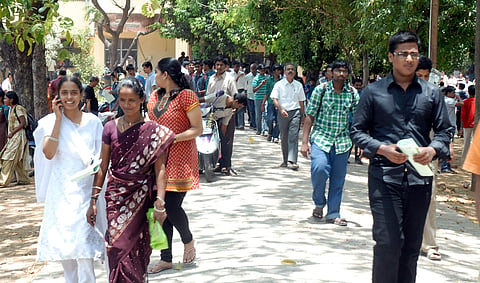

Around 10 lakh students appeared in the JEE Main 2017 examination today from over 2000 Centres in 109 cities in India and abroad.
Aspirants had the choice of appearing in any one of the two types of papers or both. Paper – I is for BE / BTech courses while Paper – II is for B.Arch / B.Planning. Paper – I on April 2, 2017 is off-line mode (pen and paper based) and on 8-9 April 2017 is online (Computer- based). Paper – II is only off-line on April 2.
Students said the examination followed the same pattern as the previous year and had no big surprises. "For me, the Physics and Chemistry papers were tougher than usual. I won't say the Maths paper was easy, it was of the same standard as last year," said Reshma, a student who took the exam at Naval Base in Kochi.
Though Aadhar cards were made mandatory this year, none of the students found it difficult to arrange one before application. 'My daughter had the Aadhar card even before the notification was out. It is a card that has become essential to do anything in the country," says a parent.
Paper 1 had a few surprises
The Question Paper – I for BE / BTech courses in 2017 is similar to the pattern in the past — 2011 to 2016. The paper has objective type questions with equal weightage to Physics, Chemistry and Mathematics. There are 30 Questions each in Physics, Chemistry & Mathematics with 4 marks for the right answer and for each incorrect response, one-fourth of the total marks allotted to the question would be deducted from the total score.
The paper is balanced and is set from CBSE syllabus of Class XI & XII, however as expected many of the questions are conceptual with some needing analytical skills. 25 questions are easy, 53 questions are of moderate difficulty and 12 questions are relatively difficult.
In D Set Q 34 & 54 of Physics are tough and need analytical ability beyond NCERT book /deep study. In Chemistry, there are 2/3 questions requiring deep conceptual understanding and application. In Mathematics Set-D Q 28 is controversial and a few questions are lengthy. However, serious students found the paper relatively easy compared to last year.
Cut-off this year is going to be higher
Cut-off for CML (Common Merit List) in 2013, 2014, 2015, 2016 was 113,115,105,100 respectively. Cut-off this year is going to be high around 115.
Admission through centralised allocation process in NIT’s / IIIT’s / DTU / CFTI’s for over 24000 seats in undergraduate courses will be according to merit list based on marks in JEE Main examination, however the candidate must be in top twenty percentile of respective board or should score minimum 75 % marks in his/her board examination. Further, a total of 9 states (Haryana, Uttarakhand, Nagaland, Gujarat, MH, MP, Odisha, Punjab, Rajasthan) will also accept JEEM ranks to fill seats through their own seat allocation process.
The top 2,20,000 candidates of JEE Main will be eligible to appear in JEE Advanced on May 21, 2017 to fight for one of 11032 seats in prestigious IITs.
(R L Trikha is the Director of FIITJEE)
